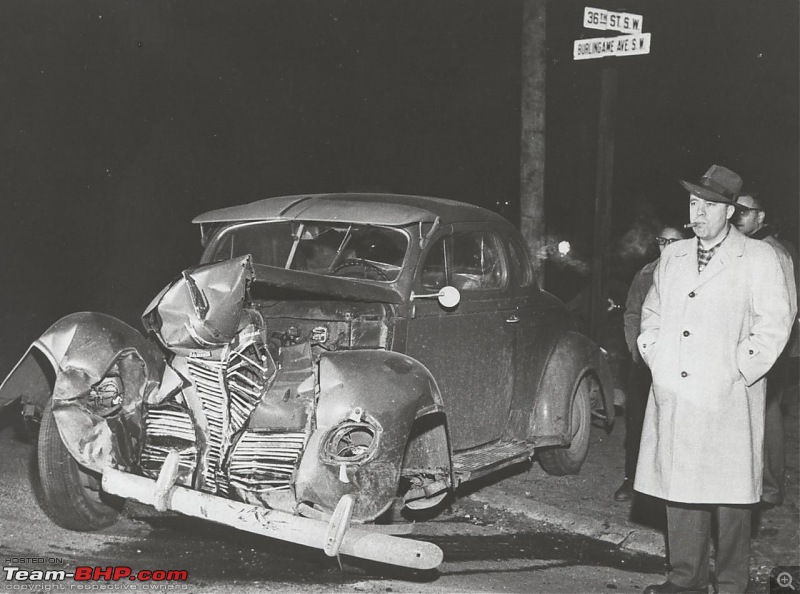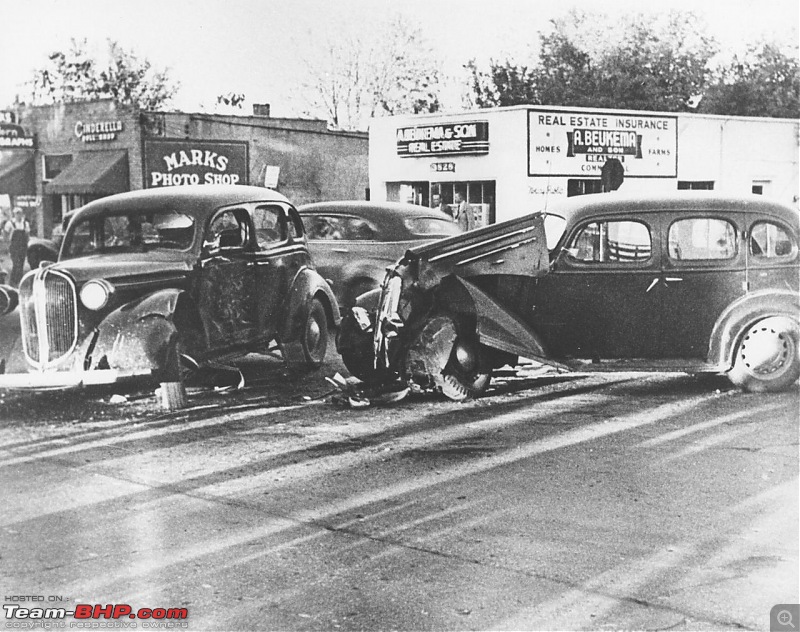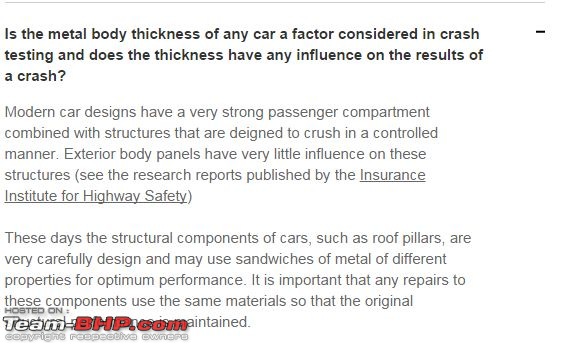Team-BHP
(
https://www.team-bhp.com/forum/)
-
Road Safety
(
https://www.team-bhp.com/forum/road-safety/)
I would say that sheet metal thickness too plays an important role in preserving the body shell poise of a car. As friends have already discussed, we find the Japanese and South Korean cars more commonly, with disfigured body shells featuring many dents over the years. A clean body line for an old car of such make is rare to find, unless the owner has kept it exceedingly well.
Comparatively, the cars with a thicker metal gauge from Europe score over their counterparts from Asia.
The older cars had thick sheets and withstood impacts better. But these were quite primitive as far as safety features were concerned. Moreover, the ladder frame chassis played havoc for the occupants in many cases, as compared to the monococques and the crumple zones or MQB platforms, that have come in the later cars.The present day ones are built to impact the engine bay or the boot with the maximum damage, but keep the passenger cabin intact. The repairs are very costly (profitable for the car maker) but lives are saved.
Thickness of the sheet metal is an "icing on the cake" for a greater structural rigidity. To make cars lighter due to design, performance and fuel economy compulsions somehow compromises upon the safety factor.
For instance, we bhpians know cars better than any average buyer and feel safe in cars with a sturdy bodyshell. An owner with an average knowledge about car may be bragging about his i 10, Verna, SX 4, Wagon R or some such model, but he or she may be unaware as to how the door thud or the sturdy feel we get while traversing potholes in safer cars make we bhpians feel safer.
And let me be very frank, monococques or MQB platforms or impact zones may make little difference in cases of smaller cars (our C segment sedans are all smaller cars) that face impact at great speeds. The car becomes a writeoff !

The passenger cabin is intact though its no monococque of any kind - the first monocoque chassis came in the Citreon Traction Avant in the 1940's.

The car has crumpled and is a total loss

Sheet metal plays a role here - the left door of the car to the left took a minimal hit
The sheet metal was thick then, with the paint layer sometimes as thick as today's sheet metal !!:Shockked:
(from google images)



A Honda City that met with an accident at a speed of 100 plus kmph, killing three of its four occupants at Nagpur in July 2014. The safety features were of no use.
Quote:
Originally Posted by anjan_c2007
(Post 3548036)
Comparatively, the cars with a thicker metal gauge from Europe score over their counterparts from Asia.
Thickness of the sheet metal is an "icing on the cake" for a greater structural rigidity. To make cars lighter due to design, performance and fuel economy compulsions somehow compromises upon the safety factor.
|
Thanks for enforcing my view.
I was just trying to articulate this in my earlier posts, maybe I need to work on how to translate my thoughts into words stupid:
Back to the topic, I agree that some kind of safety test standards are necessary and though NCAP is informative, it is not conclusive. I am not sure, but do they take into account side impacts at high speed???
My humble submission was that thicker sheet metal gives one driving the car a much safer feeling and a peace.
^Wow! Its not like that :D
Its not about metal thickness, its about how the energy of impact is absorbed, simple law of physics.
Anyways please watch these videos, maybe they clear bit of doubts:
https://www.youtube.com/watch?v=joMK1WZjP7g
Here is one Indian heavyweight - Scorpio.
Its got thick metal and lot of metal. But look how the A pillars started collapsing at such low speed crash and the dummy got crushed in the crumbled cabin. Actually the cabin starts acting like crumple zone in such car where energy absorption in not properly designed. Metal doesn't help, rather worsens the situation.
Let me also add that this Scorpio was tested in America when Mahindra planned to export it at there. So obviously they must have applied all their efforts to make this car worthy enough to pass their tests.
https://www.youtube.com/watch?v=wLmjVO3mRxE
Quote:
Originally Posted by tbppjpr
(Post 3548075)
^Wow! Its not like that :D
Its not about metal thickness, its about how the energy of impact is absorbed, simple law of physics.
Anyways please watch these videos, maybe they clear bit of doubts:
....
|
I fully agree!
I would be interested in going through any formal information on sheet material thickness making a huge impact on safety.
Assuming a car doing 100 KMPH (assuming a frontal collision; please keep in mind that a standalone obstacle vs an incoming obstacle also makes a huge difference), how many would you think that a 0.5mm (random number!) extra thickness of the metal would contribute to the well being of the occupants? In terms of physics, yes it will contribute to a 'tiny negligible extent'. Maybe the occupant of a thicker sheet will end up having 5 fractures to the femur/rib cage against 6-7 fractures (wild guess).
CD has correctly stated that the aesthetics of the car does matter. A bump from a basketball, etc. which will make sure that the 'showroom' conditions are maintained. This is exactly where thicker sheets would score. Hands down!
Otherwise when we talk about collisions, crumble zones, monocoque design will steal the show.
Quote:
Originally Posted by nkishore_007
(Post 3548497)
Assuming a car doing 100 KMPH (assuming a frontal collision; please keep in mind that a standalone obstacle vs an incoming obstacle also makes a huge difference), how many would you think that a 0.5mm (random number!) extra thickness of the metal would contribute to the well being of the occupants? In terms of physics, yes it will contribute to a 'tiny negligible extent'. Maybe the occupant of a thicker sheet will end up having 5 fractures to the femur/rib cage against 6-7 fractures (wild guess)
|
a. All the tests and data available are for frontal damage. What about to avoid an oncoming car the driver swerves, hits partially in the front and the car goes into a somersault ending up turtle.
b. What about side hits?
My submission is that in the God-forbidden situation of a high speed crash, there are loads of unforeseen factors into play --- road gradient, tyre health, speed, angle, etc. etc.
Now, a thick sheet metal although might not prove anything conclusive in the tests conducted in a controlled environment and might also not satisfy the physics purists, but it might and a BIG MIGHT --- just save you from 2 more fractured ribs or a dislocated shoulder (just a guess).
Quote:
Originally Posted by atul.sxna
(Post 3548521)
a thick sheet metal although might not prove anything conclusive in the tests conducted in a controlled environment and might also not satisfy the physics purists, but it might and a BIG MIGHT --- just save you from 2 more fractured ribs or a dislocated shoulder (just a guess).
|
Throw whatever thickness sheet metal you want into a car, it won't do any good. You will have to understand that the sheet metal doesn't contribute anything during crash, its the internal structure which decides fate of the car during crash. And you can't even imagine what thickness and strength that internal structure has got in a safely built car.
We will have to understand that there is difference between a car having thick sheet metal and a car which has got safer build quality.
Here is a very good PDF on car body structure :
http://www.alueurope.eu/wp-content/u...structures.pdf
Must read if you really want to understand how the car body is designed and how a design can make difference.
Also look at these videos to understand how car manufacturers reached onto modern car designs after carrying out lot of crash testing on their cars:
https://www.youtube.com/watch?v=A7tN...ature=youtu.be https://www.youtube.com/watch?v=siT-SIfOnQw
Quote:
Originally Posted by tbppjpr
(Post 3548523)
Throw whatever thickness sheet metal you want into a car, it won't do any good. You will have to understand that the sheet metal doesn't contribute anything during crash, its the internal structure which decides fate of the car during crash. And you can't even imagine what thickness and strength that internal structure has got in a safely built car.
We will have to understand that there is difference between a car having thick sheet metal and a car which has got safer build quality.
|
Point well taken brother.
I'm not trying to debate or even remotely undermining the importance of crumple zones, the monocoque and the strong "internal structure" which absorbs and dissipates the actual impact of the crash. I totally agree that a lot of research has gone into making our drives a lot safer over the years.
All I'm trying to say is that a thicker sheet metal might just provide an added advantage, even if only 0.1% (random figure) in case of a horrible situation.
Quote:
Originally Posted by atul.sxna
(Post 3548521)
a. All the tests and data available are for frontal damage. What about to avoid an oncoming car the driver swerves, hits partially in the front and the car goes into a somersault ending up turtle.
|
What about it? You think thicker metal sheets will put lesser harm in your scenario? I pray it does.
Quote:
Originally Posted by atul.sxna
(Post 3548521)
b. What about side hits?
|
A 0.5 mm extra thick will save/prevent injuries or something siginificant called "life" a significant 80-100 KMPH side hit?
Quote:
Originally Posted by atul.sxna
(Post 3548521)
My submission is that in the God-forbidden situation of a high speed crash, there are loads of unforeseen factors into play --- road gradient, tyre health, speed, angle, etc. etc.
Now, a thick sheet metal although might not prove anything conclusive in the tests conducted in a controlled environment and might also not satisfy the physics purists, but it might and a BIG MIGHT --- just save you from 2 more fractured ribs or a dislocated shoulder (just a guess).
|
Well, if I can save 1 rib, or femur (which I feel is equivalent to 5 ribs or more without puncture), I would any day prefer a vehicle which can substantiate my extravagance w.r.t. my spending.
Formal reports do not give the full picture (NCAP, ANCAP, etc. ), which is why this thread was opened.
Quote:
Originally Posted by nkishore_007
(Post 3548530)
What about it? You think thicker metal sheets will put lesser harm in your scenario? I pray it does.
A 0.5 mm extra thick will save/prevent injuries or something siginificant called "life" a significant 80-100 KMPH side hit?
Well, if I can save 1 rib, or femur (which I feel is equivalent to 5 ribs or more without puncture), I would any day prefer a vehicle which can substantiate my extravagance w.r.t. my spending.
Formal reports do not give the full picture (NCAP, ANCAP, etc. ), which is why CD opened this thread.
|
No, thicker metals wont do a damn thing as such. Its down to engineering and construction. No, formal reports don't give the full picture, but they are as good as it comes. To think safety is a function of the metal sheet thickness is at least not very scientific, but we live in a free country so you are allowed to think what you want. Whether that is very clever and will get you a good, thorough understanding of what makes a safe(r) car is something completely different.
Jeroen
Quote:
Originally Posted by atul.sxna
(Post 3548521)
Now, a thick sheet metal although might not prove anything conclusive in the tests conducted in a controlled environment and might also not satisfy the physics purists, but it might and a BIG MIGHT --- just save you from 2 more fractured ribs or a dislocated shoulder (just a guess).
|
If we are to go by beliefs and feelings instead of scientific data, then we might as well sum up the discussion as whatever God felt like at that point in time is going to be the outcome. You don't need a thicker sheet metal if your guardian angel is monitoring you closely. Otherwise, the thickest of the sheet metal and the best of the designs might still not be sufficient!
Quote:
Originally Posted by Jeroen
(Post 3548535)
... To think safety is a function of the metal sheet thickness is at least not very scientific, but we live in a free country so you are allowed to think what you want. Whether that is very clever and will get you a good, thorough understanding of what makes a safe(r) car is something completely different.
Jeroen
|
Definitely mate! We all are entitled to have opinions and express them in different forums.
I had mentioned in another thread that the the test results provide the trailer, the actual movie could be different. Nevertheless, it does tell us to a reasonable extent on what we can expect. But, in reality, we have several factors which comes into play (manufacturing location, driving habits, circumstantial aspects, etc.)
The following a write up from the
ANCAP  Insurance Institute of Highway Safety
Insurance Institute of Highway Safety.

So, just to build on the title of the thread-
"Sheet metal thickness - does it matter? "
Inconsequential in case of a crash at test speeds and above.
Of consequence for thud acoustics, ball impact force evasion, posterior deformity repellent.
That should keep all camps mellencampy.
Quote:
Originally Posted by atul.sxna
(Post 3548521)
a. All the tests and data available are for frontal damage. What about to avoid an oncoming car the driver swerves, hits partially in the front and the car goes into a somersault ending up turtle.
b. What about side hits?
.
|
Crash tests are frontal offsets. This means that only a portion of the front hits the other car/ obstacle. This is to simulate the driving trying to avoid scenario you mention.
On point B, side impact tests are also conducted and ratings are provided for them as well.
Quote:
Originally Posted by nkishore_007
(Post 3548497)
I fully agree!
I would be interested in going through any formal information on sheet material thickness making a huge impact on safety.
Assuming a car doing 100 KMPH (assuming a frontal collision; please keep in mind that a standalone obstacle vs an incoming obstacle also makes a huge difference), how many would you think that a 0.5mm (random number!) extra thickness of the metal would contribute to the well being of the occupants? In terms of physics, yes it will contribute to a 'tiny negligible extent'. Maybe the occupant of a thicker sheet will end up having 5 fractures to the femur/rib cage against 6-7 fractures (wild guess).
CD has correctly stated that the aesthetics of the car does matter. A bump from a basketball, etc. which will make sure that the 'showroom' conditions are maintained. This is exactly where thicker sheets would score. Hands down!
Otherwise when we talk about collisions, crumble zones, monocoque design will steal the show.
|
Chances of survival are slim in an actual impact at 100 kmph. Most of the times people are able to slow down by braking before the impact. Take a look at this article that explains that even cars that got a 5 star rating at 64 kmph were not able to withstand an increase to 80 kmph:
http://www.motorauthority.com/news/1...top-rated-cars
My understanding and belief is thin sheet with modern design will always be less safer than a thick sheet modern design car . To put it shortly a Skoda is more safer than a Accord , A Vento/Linea i safer than than a City/Ciaz.In real world accidental forces come from all directions against what happens in NCAP etc tests where the direction , height of forces imparted on test vehicles is calculated / controlled tightly. Eg A Vento will prove safer when a truck sidewash the car against a Ciaz in same situation .Also when a structure itself is weak adding air bags really doesnot make a difference especially in high G force accidents which was proved recently owing to which Polo started getting airbags as standard.
Quote:
Originally Posted by Trust_In_Thrust
(Post 3549035)
My understanding and belief is thin sheet with modern design will always be less safer than a thick sheet modern design car . To put it shortly a Skoda is more safer than a Accord , A Vento/Linea i safer than than a City/Ciaz.--------snip
|
Please don't live by those words, and also, don't throw out such a generalization that the difference is due to thickness of the sheet metal.
The safest cars in the world don't even have sheet metal, and if you show CF shattering to a (rich) layman, he will, when he buys his next pagani, replace all the panels with spec built iron sheets, because it does not turn into "poder ".
Will he be safer? In his mind...... Yes.
| All times are GMT +5.5. The time now is 08:34. | |









